
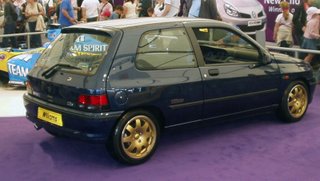
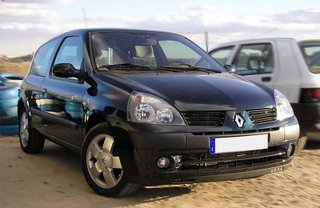
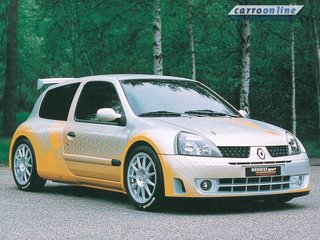
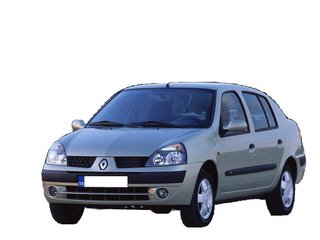
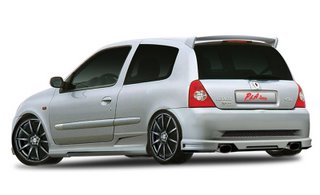
The Renault Clio is a supermini/subcompact produced by the French automaker Renault. Originally launched in 1990, it is currently in its third generation. The Clio has seen substantial critical and commercial success, being consistently one of Europe's top-selling cars since its launch, and it is largely credited with restoring Renault's reputation and stature after a difficult second half of the 1980s.
The Clio has been sold as the Renault Lutecia in Japan. A four-door sedan was developed for certain markets where sedans are traditionally preferred over hatchbacks and was sold under names Renault Clio Symbol, Renault Clio Sedan and Renault Thalia. It is also sold under the Nissan nameplate in some Latin American markets as the Nissan Platina with slight changes in the front of the car.Clio (1990-1998)
The Clio was introduced at the Paris Motor Show in the autumn of 1990 and began sales in France soon after, although sales in the rest of Europe did not begin until March 1991. The Clio largely replaced the Renault 5 (which continued to be built until 1996 as a budget alternative). The engine range available at launch included 1.2 L and 1.4 L E-type "Energy" gasoline I4 engines (first seen in the R19) and 1.7 L and a 1.9 L diesel (both based on the F-type unit) engines. The gasoline engines all received a fuel injection system in place of carburettors in 1992, in order to conform to new pollutant emission regulations.
A minor trim facelift occurred after only a year of being on sale. A new "smooth" version of the Renault diamond badge (the previous "ribbed" badge was being phased out at the time) and a new front seat design were the only changes. The altered design did not constitute a new 'phase'. In March 1994 the Phase 2 model was launched, with small updates to the exterior and interior of the Clio. Most noticeable was the change in the front grille from two metal ribs to a single colour-coded slat grille. The bump strips were made slightly larger and rounder, and the car's trim level badge was incorporated into the bump strips. The badges on the tailgate strip were moved up onto the tailgate itself and the tailgate strip was given a carbon fibre look. The rear light clusters were given a slightly more rounded 'bubble' shape to them, giving the Clio a more modern look. The clusters, however, are physically interchangeable with Phase 1 clusters.
In 1996, with the arrival of the Phase 3 'facelift' Clio, the 1.2 L Energy engine was replaced by the 1149 cc D7F MPi (Multi Point Injection) 'DiET' engine, first used in the Renault Twingo; for some time also, versions were available with the older 1239 cc "Cléon" unit from the original Twingo. The cylinder head design on the 1.4 L E-Types was also slightly altered for the Phase 3 models in a bid for better fuel economy. This resulted in the engines producing slightly less power than their earlier versions.
The Phase 3 Clios had a slightly more noticeable update than the Phase 2's. The Phase 3 has different, more rounded headlights, incorporating the turn signal in the unit with the headlight. The bonnet curved more around the edges of the lights. The tailgate incorporated a third brake light and a new script "Clio" name badge, following the same typeface as contemporary Renaults. Some mechanical improvements were also made.
During 1991 a 1.8 L 16-valve engine producing 137 hp (also first seen in the R19) capable of propelling the car to 125 mph was introduced to the Clio engine range. This was simply called 'Clio 16v'. As well as having better performance than a regular Clio, the 16v sported wider plastic front bumpers, an offset bonnet vent, wider rear bumpers and uprated suspension and brakes, and colour-coded front mirrors and bumpers.
Renault also released a "warm-hatch" version of the Clio. It was aesthetically very similar to the Clio RT, but with the addition of a 110 hp 1.8 L 8-valve engine, side skirts and disc brakes on all wheels. This was badged as the 'RSi'.
The Clio was voted 1991 European Car of the Year, and the Clio immediately became one of Europe's best-selling cars, as well as the first Renault to be consistently among the top-10 best sellers in the United Kingdom. UK sales were helped by a famous television advertising campaign by Publicis shot in France, featuring the two main characters of Nicole (played by Estelle Skornik, who ironically was not French nor did she have a driving licence at the time) and Papa.
In 1993, the Clio Williams was launched (with a limited run of just 400 right hand drive cars in the UK), named after the then Renault-powered Formula One team WilliamsF1. Contrary to expectations, Williams had nothing to do with the design or engineering of this Clio; the modifications to the Clio 16v on which it was based were the work of Renault Sport - Renault's motorsport division. It had a 2.0 L 16-valve I4 engine rated at 110 kW (150 bhp DIN) and a top speed of more than 217 km/h (135 mph), with performance-tuned ride and handling. Renault later released the Williams 2 and Williams 3 special editions, much to the chagrin of those owners who had been assured of the exclusivity of the "original" Williams. The differences between the three versions of the Williams were largely a reflection of phase changes across the Clio range e.g. the gradual addition of enhanced safety features and cosmetic variations. Other than this, the Williams 1 and 2 had no sunroof and were painted in 449 Sports Blue. The final Williams 3 was painted in a slightly brighter shade of blue and finally gained a sunroof which had long been standard on virtually all previous Clios. The original Williams was the lightest of the three, lacking the electrics necessary for the sunroof or the mirrors but was the only one to sport a metal plaque stating the build number (out of 400). However, the rarest model was actually the Willams 3 with official Renault figures in the UK putting it at well below the 400 original cars and therefore more 'limited edition'. Respected motoring journalists consistently rate the Williams as one of the very best 'hot hatches' ever made, regardless of era.
Clio II (1998-2001)
The all-new second generation of the Clio was launched in the spring of 1998, with considerably more rounded and bulbous styling than its predecessor. Part of the radical concept of the new Clio were many components made of unusual materials to save in weight and repair costs. For instance, the front wings were made of plastic and the material of the bonnet was aluminium in some versions. Originally the engine lineup was similar to before, with 1.2 L, 1.4 L and 1.6 L gasoline engines and a 1.9 L diesel. In early 1999, a sportive 16V version equipped with a new 1.6 L 16-valve engine was introduced, and eventually, all the older gasoline engines were upgraded to more powerful and more economical 16-valve versions.
In 1999, Renault launched the 172 hp Clio RS (short for Renault Sport), named Clio Renault Sport 172, with a 2.0 L 16-valve engine and a top speed of 220 km/h (137 mph). But in this form, the car is capable of surprisingly good handling and performance. The top-of-the-range Clio however was the exotic mid-engined, rear-wheel drive Clio V6 Renault Sport, which placed a 166 kW (230 hp) 3.0 L V6 engine sourced from the Renault Laguna behind the front seats, with a top speed of 235 km/h (146 mph).
[edit] Clio II facelift (2001-present)
A facelift in the spring of 2001 saw the exterior restyled, the interior quality improved and a 1.5 L direct-injection diesel engine added. The Clio 172 was also facelifted and a lightened more focused version was also added to the range, known as the 172 Cup. The Cup also benefited from tuned suspension designed for race track handling.
The 172 later received a further upgrade to 182 bhp, becoming the Renaultsport Clio 182, the Clio 182 Cup, and finally a top-of-the-range ultimate version called the Clio 182 Trophy. The Trophy has been heralded as one of the best hot hatches of all time and won 'Evo' magazine's People's Performance Car of The Year, 2005, beating rivals such as the Lamborghini Gallardo and other exotica in the process. Only 500 were made for the UK (and a handful for Switzerland). The main difference between the Trophy and the normal 182 and 182 Cup is the race-engineered suspension that affords the Trophy handling unparalled in its market. Renault also produced the Clio v6, which looks like its on steroids compared to the 182, the V6 has a 255bhp 24v 3.0 liter enginer with a 0 - 62.5 speed of 5.8sec and a top speed of 153mph. Renault decided to keep selling the Clio II until 2008; the Clio II is sold alongside with the Clio III; but with a smaller price and known as the Clio Campus. In 2006 this model was facelifted with a restyled front and rear. The number plate moves from boot (or trunk) to bumper.
Clio Symbol/Clio Sedan/Thalia (2001-present)
In 2001 Renault launched the sedan version of the Clio II, named Clio Symbol (Turkey, Romania and Bulgaria), Thalia (the rest of Eastern Europe) or Clio Sedan (Southern Cone). Originally, the car was intended for sale in developing countries, but due to demand, it was later made available in countries where sedans were traditionally preferred over hatchbacks, most notably Spain and a few countries in Eastern Europe. In Eastern Europe, the Thalia is cheaper than the Clio, but is still about 30% more expensive than the Dacia Logan, which is also sold by Renault in that market but s a low cost model. In a few markets where Renault was not present, the sedan was offered as the Nissan Platina (manufactured and sold in Mexico at a Renault-Nissan factory and sold throughout Central America), with two exceptions being Chile and the Dominican Republic, where both the Nissan and Renault models are present.
Clio III (2005-present)
An all-new third generation Clio was unveiled in 2005. It uses a platform co-developed with Nissan (which Renault has a share in) that is shared with the Renault Modus, the current Nissan Micra and the Nissan Note. It is considerably larger and 130 kg heavier as well as more expensive than the Clio II, the result of a decision to move the Clio slightly upmarket. The outgoing Clio II will continue to be sold as a budget option until the launch of the new Renault Twingo (expected 2007). The new Clio achieved a 5-star EuroNCAP safety rating, joining the rest of Renault's family of top-rated consumer motors - with the exception of the Kangoo - which all have the maximum safety rating. Sales of the 3-door model begun throughout Europe in October 2005, with a 5-door model to follow in early 2006.
In June 2006 the sales of the third generation Clio Renault Sport started in France for the price of 23000 euros. Clio Renault Sport is equipped with a new naturally aspirated 16-valve 2 liter engine based on the earlier version used in the second generation Clio Renault Sport and a 6-speed gearbox. The engine develops 145 kW (197 hp) at 7250 rpm. The top speed is 215 km/h and 0-100 km/h takes 6.9 seconds.
Renault exhibited a Hi-Flex Clio with a 1.6 L 16-valve engine at the 2006 Paris International Agricultural Show. This vehicle, which addresses the Brazilian market, features Renault-developed flex-fuel technology, with a highly versatile engine that can run on fuel containing a blend of gasoline and ethanol in any proportion (0% to 100% of either)
The Clio has been sold as the Renault Lutecia in Japan. A four-door sedan was developed for certain markets where sedans are traditionally preferred over hatchbacks and was sold under names Renault Clio Symbol, Renault Clio Sedan and Renault Thalia. It is also sold under the Nissan nameplate in some Latin American markets as the Nissan Platina with slight changes in the front of the car.Clio (1990-1998)
The Clio was introduced at the Paris Motor Show in the autumn of 1990 and began sales in France soon after, although sales in the rest of Europe did not begin until March 1991. The Clio largely replaced the Renault 5 (which continued to be built until 1996 as a budget alternative). The engine range available at launch included 1.2 L and 1.4 L E-type "Energy" gasoline I4 engines (first seen in the R19) and 1.7 L and a 1.9 L diesel (both based on the F-type unit) engines. The gasoline engines all received a fuel injection system in place of carburettors in 1992, in order to conform to new pollutant emission regulations.
A minor trim facelift occurred after only a year of being on sale. A new "smooth" version of the Renault diamond badge (the previous "ribbed" badge was being phased out at the time) and a new front seat design were the only changes. The altered design did not constitute a new 'phase'. In March 1994 the Phase 2 model was launched, with small updates to the exterior and interior of the Clio. Most noticeable was the change in the front grille from two metal ribs to a single colour-coded slat grille. The bump strips were made slightly larger and rounder, and the car's trim level badge was incorporated into the bump strips. The badges on the tailgate strip were moved up onto the tailgate itself and the tailgate strip was given a carbon fibre look. The rear light clusters were given a slightly more rounded 'bubble' shape to them, giving the Clio a more modern look. The clusters, however, are physically interchangeable with Phase 1 clusters.
In 1996, with the arrival of the Phase 3 'facelift' Clio, the 1.2 L Energy engine was replaced by the 1149 cc D7F MPi (Multi Point Injection) 'DiET' engine, first used in the Renault Twingo; for some time also, versions were available with the older 1239 cc "Cléon" unit from the original Twingo. The cylinder head design on the 1.4 L E-Types was also slightly altered for the Phase 3 models in a bid for better fuel economy. This resulted in the engines producing slightly less power than their earlier versions.
The Phase 3 Clios had a slightly more noticeable update than the Phase 2's. The Phase 3 has different, more rounded headlights, incorporating the turn signal in the unit with the headlight. The bonnet curved more around the edges of the lights. The tailgate incorporated a third brake light and a new script "Clio" name badge, following the same typeface as contemporary Renaults. Some mechanical improvements were also made.
During 1991 a 1.8 L 16-valve engine producing 137 hp (also first seen in the R19) capable of propelling the car to 125 mph was introduced to the Clio engine range. This was simply called 'Clio 16v'. As well as having better performance than a regular Clio, the 16v sported wider plastic front bumpers, an offset bonnet vent, wider rear bumpers and uprated suspension and brakes, and colour-coded front mirrors and bumpers.
Renault also released a "warm-hatch" version of the Clio. It was aesthetically very similar to the Clio RT, but with the addition of a 110 hp 1.8 L 8-valve engine, side skirts and disc brakes on all wheels. This was badged as the 'RSi'.
The Clio was voted 1991 European Car of the Year, and the Clio immediately became one of Europe's best-selling cars, as well as the first Renault to be consistently among the top-10 best sellers in the United Kingdom. UK sales were helped by a famous television advertising campaign by Publicis shot in France, featuring the two main characters of Nicole (played by Estelle Skornik, who ironically was not French nor did she have a driving licence at the time) and Papa.
In 1993, the Clio Williams was launched (with a limited run of just 400 right hand drive cars in the UK), named after the then Renault-powered Formula One team WilliamsF1. Contrary to expectations, Williams had nothing to do with the design or engineering of this Clio; the modifications to the Clio 16v on which it was based were the work of Renault Sport - Renault's motorsport division. It had a 2.0 L 16-valve I4 engine rated at 110 kW (150 bhp DIN) and a top speed of more than 217 km/h (135 mph), with performance-tuned ride and handling. Renault later released the Williams 2 and Williams 3 special editions, much to the chagrin of those owners who had been assured of the exclusivity of the "original" Williams. The differences between the three versions of the Williams were largely a reflection of phase changes across the Clio range e.g. the gradual addition of enhanced safety features and cosmetic variations. Other than this, the Williams 1 and 2 had no sunroof and were painted in 449 Sports Blue. The final Williams 3 was painted in a slightly brighter shade of blue and finally gained a sunroof which had long been standard on virtually all previous Clios. The original Williams was the lightest of the three, lacking the electrics necessary for the sunroof or the mirrors but was the only one to sport a metal plaque stating the build number (out of 400). However, the rarest model was actually the Willams 3 with official Renault figures in the UK putting it at well below the 400 original cars and therefore more 'limited edition'. Respected motoring journalists consistently rate the Williams as one of the very best 'hot hatches' ever made, regardless of era.
Clio II (1998-2001)
The all-new second generation of the Clio was launched in the spring of 1998, with considerably more rounded and bulbous styling than its predecessor. Part of the radical concept of the new Clio were many components made of unusual materials to save in weight and repair costs. For instance, the front wings were made of plastic and the material of the bonnet was aluminium in some versions. Originally the engine lineup was similar to before, with 1.2 L, 1.4 L and 1.6 L gasoline engines and a 1.9 L diesel. In early 1999, a sportive 16V version equipped with a new 1.6 L 16-valve engine was introduced, and eventually, all the older gasoline engines were upgraded to more powerful and more economical 16-valve versions.
In 1999, Renault launched the 172 hp Clio RS (short for Renault Sport), named Clio Renault Sport 172, with a 2.0 L 16-valve engine and a top speed of 220 km/h (137 mph). But in this form, the car is capable of surprisingly good handling and performance. The top-of-the-range Clio however was the exotic mid-engined, rear-wheel drive Clio V6 Renault Sport, which placed a 166 kW (230 hp) 3.0 L V6 engine sourced from the Renault Laguna behind the front seats, with a top speed of 235 km/h (146 mph).
[edit] Clio II facelift (2001-present)
A facelift in the spring of 2001 saw the exterior restyled, the interior quality improved and a 1.5 L direct-injection diesel engine added. The Clio 172 was also facelifted and a lightened more focused version was also added to the range, known as the 172 Cup. The Cup also benefited from tuned suspension designed for race track handling.
The 172 later received a further upgrade to 182 bhp, becoming the Renaultsport Clio 182, the Clio 182 Cup, and finally a top-of-the-range ultimate version called the Clio 182 Trophy. The Trophy has been heralded as one of the best hot hatches of all time and won 'Evo' magazine's People's Performance Car of The Year, 2005, beating rivals such as the Lamborghini Gallardo and other exotica in the process. Only 500 were made for the UK (and a handful for Switzerland). The main difference between the Trophy and the normal 182 and 182 Cup is the race-engineered suspension that affords the Trophy handling unparalled in its market. Renault also produced the Clio v6, which looks like its on steroids compared to the 182, the V6 has a 255bhp 24v 3.0 liter enginer with a 0 - 62.5 speed of 5.8sec and a top speed of 153mph. Renault decided to keep selling the Clio II until 2008; the Clio II is sold alongside with the Clio III; but with a smaller price and known as the Clio Campus. In 2006 this model was facelifted with a restyled front and rear. The number plate moves from boot (or trunk) to bumper.
Clio Symbol/Clio Sedan/Thalia (2001-present)
In 2001 Renault launched the sedan version of the Clio II, named Clio Symbol (Turkey, Romania and Bulgaria), Thalia (the rest of Eastern Europe) or Clio Sedan (Southern Cone). Originally, the car was intended for sale in developing countries, but due to demand, it was later made available in countries where sedans were traditionally preferred over hatchbacks, most notably Spain and a few countries in Eastern Europe. In Eastern Europe, the Thalia is cheaper than the Clio, but is still about 30% more expensive than the Dacia Logan, which is also sold by Renault in that market but s a low cost model. In a few markets where Renault was not present, the sedan was offered as the Nissan Platina (manufactured and sold in Mexico at a Renault-Nissan factory and sold throughout Central America), with two exceptions being Chile and the Dominican Republic, where both the Nissan and Renault models are present.
Clio III (2005-present)
An all-new third generation Clio was unveiled in 2005. It uses a platform co-developed with Nissan (which Renault has a share in) that is shared with the Renault Modus, the current Nissan Micra and the Nissan Note. It is considerably larger and 130 kg heavier as well as more expensive than the Clio II, the result of a decision to move the Clio slightly upmarket. The outgoing Clio II will continue to be sold as a budget option until the launch of the new Renault Twingo (expected 2007). The new Clio achieved a 5-star EuroNCAP safety rating, joining the rest of Renault's family of top-rated consumer motors - with the exception of the Kangoo - which all have the maximum safety rating. Sales of the 3-door model begun throughout Europe in October 2005, with a 5-door model to follow in early 2006.
In June 2006 the sales of the third generation Clio Renault Sport started in France for the price of 23000 euros. Clio Renault Sport is equipped with a new naturally aspirated 16-valve 2 liter engine based on the earlier version used in the second generation Clio Renault Sport and a 6-speed gearbox. The engine develops 145 kW (197 hp) at 7250 rpm. The top speed is 215 km/h and 0-100 km/h takes 6.9 seconds.
Renault exhibited a Hi-Flex Clio with a 1.6 L 16-valve engine at the 2006 Paris International Agricultural Show. This vehicle, which addresses the Brazilian market, features Renault-developed flex-fuel technology, with a highly versatile engine that can run on fuel containing a blend of gasoline and ethanol in any proportion (0% to 100% of either)





No comments:
Post a Comment